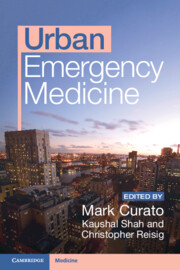Book contents
- Urban Emergency Medicine
- Urban Emergency Medicine
- Copyright page
- Contents
- Contributors
- Preface
- Chapter 1 Caring for the Homeless
- Chapter 2 Disruptive and Dangerous Agitation
- Chapter 3 Penetrating Trauma
- Chapter 4 Substance Use
- Chapter 5 Human Trafficking
- Chapter 6 Travelers from Overseas
- Chapter 7 HIV, AIDS, and Tuberculosis
- Chapter 8 Asthma
- Chapter 9 Physician/Patient Discordance
- Chapter 10 LGBTQIA+ Care
- Chapter 11 Child Maltreatment
- Chapter 12 Care of Vulnerable Elders
- Chapter 13 Civil Unrest: Caring for Police and Protesters
- Chapter 14 Terrorism and Mass Casualty Incidents
- Chapter 15 Overcrowding, Triage, and Care Rationing
- Index
- References
Chapter 11 - Child Maltreatment
Published online by Cambridge University Press: 20 July 2023
- Urban Emergency Medicine
- Urban Emergency Medicine
- Copyright page
- Contents
- Contributors
- Preface
- Chapter 1 Caring for the Homeless
- Chapter 2 Disruptive and Dangerous Agitation
- Chapter 3 Penetrating Trauma
- Chapter 4 Substance Use
- Chapter 5 Human Trafficking
- Chapter 6 Travelers from Overseas
- Chapter 7 HIV, AIDS, and Tuberculosis
- Chapter 8 Asthma
- Chapter 9 Physician/Patient Discordance
- Chapter 10 LGBTQIA+ Care
- Chapter 11 Child Maltreatment
- Chapter 12 Care of Vulnerable Elders
- Chapter 13 Civil Unrest: Caring for Police and Protesters
- Chapter 14 Terrorism and Mass Casualty Incidents
- Chapter 15 Overcrowding, Triage, and Care Rationing
- Index
- References
Summary
While child maltreatment is a global problem, urban settings highlight the problem due to large concentrations of people, which increase the likelihood that the maltreatment will be noticed and reported; urban Emergency Departments (EDs) are particularly situated for the detection of child maltreatment. The ability of the emergency physician to recognize and respond to child maltreatment is crucial in preventing further harm to the child. Emergency physicians are also mandated reporters, and are required by law to inform child protective services of all suspected cases. There are certain risk factors for child abuse and subtle red flags in the history and physical exam that we must familiarize ourselves with in order to appropriately identify child abuse. These risk factors and rates of child abuse may be unique for the clinician practicing emergency medicine in an urban setting. The evaluation of a child with suspected abuse also requires an extensive workup and detailed documentation, and such cases are prone to medical and legal consequences.
Keywords
- Type
- Chapter
- Information
- Urban Emergency Medicine , pp. 133 - 147Publisher: Cambridge University PressPrint publication year: 2023



